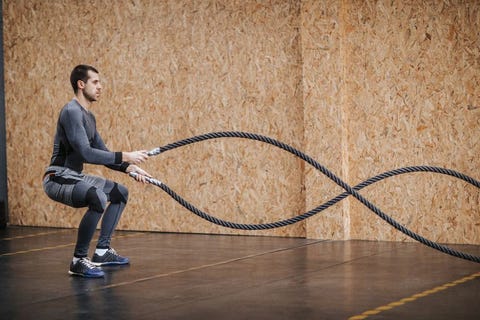For some exercise junkies, the perfect workout consists of heavy weights, clanking iron, and long breaks to recover. But not everyone hits the gym with muscle growth and building strength as the end all, be all goal. If your objectives are to improve your fitness level, burn some fat, and break a sweat, you’re going to have to pick up the pace beyond those 90 second rest periods and mix in some cardio elements to your workout.
One of the best, most popular ways to introduce some cardio without entering the boring steady state zone of treadmills and stationary bikes is by implementing high intensity interval training protocols. Even if that long, word salad phrase isn’t familiar to you, you probably know the more common acronym from countless boutique gym concepts and online workouts: HIIT.
The protocol is popular for a reason. HIIT allows trainers to pack a ton of work into a small amount of time, making workouts effective, quick, and more engaging than a long slog on a cardio machine. HIIT workouts burn fat and push your heart rate, and allow you to keep the weights in your training. Because of the second word in the acronym, ‘intensity,’ exercisers are likely to feel super accomplished after surviving a particularly challenging session.
But in some contexts, particularly in the boutique gym space, HIIT is overused and misapplied—and that intensity is the only aspect of the protocol that carries over into practice. As HIIT has become a fitness buzzword, the exact specifications of the protocol have become hazy to the general public, so any workout that gets people up and moving is tagged with the label. That’s not quite right. There are specifications that matter.
For HIIT to be utilized correctly, your intensity has to be high–but you need to know how to apply the protocol. That’s what you’re going to learn here, and you’ll also walk away with a handful of HIIT workouts for every situation, too.
HIIT 101
HIIT stands for high-intensity interval training, which refers to the short bursts of intense exercise alternated with low-intensity recovery periods that make up the protocol. HIIT is quick and anything but boring, as its exacting work-to-rest ratios make it arguably the most time-efficient way to exercise and burn calories. You can use the HIIT protocol to build your entire workout, or apply it to just a few sets to create super-charged finishers.
However you do it, what makes HIIT work is the intensity. You’re going hard, typically as hard as you can, for a short period of time, then resting for a length of time that’ll let you recover to go hard once again. Work-to-rest ratio is frequently brought in when discussing HIIT, and there are several accepted ratios you should consider.
The Key to HIIT
The key to making HIIT work: The intensity. You can’t coast through your work periods when doing HIIT. The protocol is designed to give you chances to go hard, so you need to take advantage of those chances.
That means working hard, but it doesn’t mean going completely 100 percent with your intensity. If you’re completely new to exercise, don’t go truly all out all at once. Instead of 15 to 30-second intervals executed at near-100 percent intensity, intervals of one to three minutes at closer to 80 percent of maximum effort, followed by up to five minutes of lower intensity exercise, have also been shown effective for weight loss in sedentary populations.
In group fitness settings (and among far too many trainers) HIIT and “interval training” are often used interchangeably. Make no mistake: True HIIT requires you to be explosive and intense during your work period. Basic interval training, however, minus the high-intensity aspect, is what you see most on the group fitness scene: Work periods here are typically larger than rest periods.
The Primary Benefits of HIIT
Fat Loss
One review looked at 13 different studies on 424 overweight and obese adults. It found that both HIIT and traditional moderate-intensity exercise can reduce weight and waist circumference.
Metabolic Rate Is Higher for Hours After
Some researchers have found that HIIT increases metabolism for hours after exercise even more than jogging and weight training. This is known as excess post-exercise oxygen consumption (EPOC, informally called afterburn), a measurably increased rate of oxygen intake following strenuous activity.
Overall Health
HIIT is not just a tool to use to lean out. It can improve your overall health, too. A summary of 50 different studies found that HIIT reduces blood sugar levels. Further research shows it can reduce resting heart rate and blood pressure in overweight and obese individuals.
Some Ways to HIIT
So, wait, you’re still technically on that dreaded treadmill, right? Not necessarily. Here are 14 HIIT workouts that can keep you off the treadmill (well, for the most part) and on a far more fun path to major fat-burn.
All Out Studio Upper Body HIIT
This dumbbell workout from All Out Studio’s High Power HIIT program by trainer Gerren Liles will help you to sculpt your chest, arms, and back while ramping up the pace. You’ll be toast after these 15 minutes.
Close-Grip Chest Press – 30 seconds
Close-Grip Chest Press with Crunch – 45 seconds
Close-Grip Chest Press with Crunch and Leg Lowers – 75 seconds
Squat Hold – 45 seconds
Renegade Rows – 30 seconds
Weighted Walkout to Renegade Row – 45 seconds
Weighted Walkout to Renegade Row to Knee Raise and Twist – 75 seconds
Squat Hold – 45 seconds
Dumbbell Over-the-Shoulder Chops – 30 seconds
Squat and Over-the-Shoulder Chops – 45 seconds
Squat Thrust and Over-the-Shoulder Chops – 75 seconds
Cooldown Stretch – 45 seconds
Gerren Liles’ Line and Back Challenge Workout
This session from Liles introduces a challenging wrinkle to the protocol.
You’ll place the four objects out in front of you in a row, spaced about a foot apart from each other and six feet from your own starting position. Assign each object a number, 1 through 4. You’ll begin at the starting position performing an exercise, until Liles calls out a number (or a series of numbers) associated with the objects in front of you. Run up to the row of props, touch the object that he called out, then return to the starting point to begin performing the exercise. If he calls out multiple numbers, return to the starting line after each touch. Each round last for 3 minutes.
The Exercises
Squat Jumps
Pushups with Shoulder Taps
Lunge to Split Jumps
Plank to Hip Dips
Burpee 180° Turn
Bobby Maximus’ Bodyweight Tabata Blast
There are multiple protocols under the HIIT umbrella, the most popular of which might just be Tabata training. The extra-intense format consists of 8 rounds of 20 seconds of all-out work, then 10 seconds of rest. To save you some math, that’s just 4 minutes of work—but the effort makes it worth your while. Here, trainer Bobby Maximus strings together four bodyweight movements for one 16-minute Tabata session: squats, lunges, squat holds, and pushups.
The Basic Sprint Interval
Here’s your ideal HIIT treadmill workout. Warm up with a quick 3-minute jog, then immediately boost the speed so you’re sprinting as fast as you can for 15 to 20 seconds. After that, walk, or jog at a very slow pace for one minute. Then it’s back to sprints.
Repeat this for 10 rounds and you’ll get 15 minutes of good sweat. This works on a treadmill, but it can easily work on a track or football field, too.
The Bodyweight Tabata Circuit
Forget running entirely and get comfortable with bodyweight exercises, again using the dreaded Tabata protocol. Here, you’ll choose a bodyweight move and do it for 20 seconds. Then you’ll rest 10 seconds.
During your 20 seconds of work, make sure to go hard, then rest. Do a maximum of 8 sets.
Yes, that means you’ll be done in exactly four minutes, but that’s half the fun of a tabata. When done correctly, if you’re going hard enough, you’re wiped out after that four minutes, because the electrically fast work intervals are broken up by a mere 10 seconds of rest.
You can do tabata circuits with almost any bodyweight moves you want to use. Try integrating moves like burpees, squats, and mountain climbers. Not sure how to perfectly do a burpee? Check out the video below.
The Bike Sprint
Have a stationary bike? Then blow up your quads and hamstrings with this sneaky HIIT workout. Pedal as hard and fast as you possibly can for 30 seconds, focusing on turning your legs over at a fast pace. Make sure you have some resistance on the bike, too; don’t set it to the lowest resistance.
After that, pedal slowly for one minute at an easy pace. Repeat this for 10-20 rounds, depending on how much time you have.
The Battle Ropes Blitz
Don’t make it complicated. Just moving battle ropes at a fast and aggressive pace will ramp up your heart rate. So grab a pair of battle ropes and start doing slams or waves; work for 30 seconds. Rest for about a minute. Repeat for 10 rounds.
The Hill Sprint Series
There’s running — and then there are hill sprints. Sprinting on an incline is a brilliant way to train, preventing you from overstriding and also decreasing the impact on your joints. You’ll be far less prone to a hamstring tweak on a hill sprint than you would be on a flat surface.
This one programs itself, too, and doesn’t force you to constantly stare at the clock. Find a hill and sprint up for 20-30 seconds. Then walk back down to your starting point; this serves as your recovery period. Repeat for 10 rounds.
The Sled Push Slam
The sled helps you improve your anaerobic conditioning, letting you battle through sprints that are over quickly. Those sprints are also super-intense, though, because you’re pushing a heavy sled, driving harder than you might if you were just running with bodyweight.
To do this sled push workout, load 70 to 85 percent of your max pushing capacity o the sled; you want to make sure you’re working hard. Now push it explosively, as hard and fast as you can, until you can barely move it. If you choose the right weight, this will be over in seconds — but you’ll still feel pretty fatigued. Rest for 3 minutes; repeat for 4 or 5 rounds.
The Rowing Ab Blast
https://www.instagram.com/p/BvS3UyoheFA/
A post shared by Ebenezer Samuel (@ebenezersamuel23)
This one will leave your glutes and abs on fire (and leave you out of breath too), and it relies on the popular EMOM format. That means “every minute, on the minute,” you’ll have to do a certain brand of work.
Set a rower for 2,000 meters. Row for exactly one minute. At 1:00, get off the rower. Do 5 hollow rocks then immediately get back on the rower and keep rowing. At 2:00, get off and do 6 hollow rocks, then start rowing again. Continue doing this, getting off the rower and doing hollow rocks at the start of each minute, until you’ve rowed all 2,000 meters. This may seem very close to work capacity training, but as the rounds wear on, you’ll be given more and more opportunity to be explosive, as the work periods of rowing increasingly shrink as you battle through the hollow rocks.
The Partner Rower Crusher
https://www.instagram.com/p/By-7dBcniYI/
A post shared by Ebenezer Samuel (@ebenezersamuel23)
Find a partner and get ready to hit this underrated 8-minute rowing assault. Start on the rower, and start with the number 15. You have 30 seconds to row for that many calories.
At 30 seconds, if you’ve completed the calories, both you and your partner get to rest. If you haven’t, your partner does squat reps for every calorie you didn’t complete. So if you only hit 13 cals, your partner does 2 squats. If you hit 5 cals, your partner does 15 squats.
You partner has to finish in 30 seconds, though, because then they hop on the rower for a 30-second rowing interval, with the same rules. Except this time, add two cals to the workload. That means your partner has to do 17 cals (and if they fall short, you have to make up the difference in squats).
Keep going for 8 minutes, adding 2 cals to the workload every minute.
The 100s Crush
https://www.instagram.com/p/B3UWx03HPbE/
A post shared by Don Saladino (@donsaladino)
Grab a cardio machine, such as a treadmill, rower, or Ski-Erg and set it for a 100-meter sprint (or, if you’re on a Versaclimber, a 100-foot race to the top). Blast through that distance as fast as possible, then rest until your heart rate drops below 120 beats per minute.
Repeat for 10 rounds. This one’s better with a partner, too, because then you find yourself racing to each distance, and you may push a bit harder.
The Total Body Beatdown
Set a timer for 12 minutes, and get ready to rock your whole body. This is another EMOM circuit. So you’ll have one minute to do each move, then you’ll rest until the start of the next minute. The faster you finish your reps, the more time you get to rest. Don’t get sloppy with your technique, though; continue to do good quality reps, even though you do want to move fast.
Minute 1: 15 air squats
Minute 2: 15 burpees
Minute 3: 10 lying Superman holds
Repeat 4 times.
The Ski-Erg Shred
This one is built to fry your whole body, but it’ll attack your abs and back more than anything. It’s Tabata-style, too, so you’re going to get a lot of good work into just six minutes. Grab a Ski Erg’s handles and working, going for 20 seconds as hard as you can, focusing on being explosive. Rest for 10 seconds.
Now kneel on the Ski-Erg (grab a pad for your knees if you want). Go hard for 20 seconds again. You won’t be able to use your legs as much, so you’ll need to focus on driving with your core and lats. Rest for 10 seconds.
Now kneel on one knee. Go hard for 20 seconds again; this time, your base will be narrower so you’ll need to focus more on not tipping from side to side. Rest 10 seconds.
Kneel on the opposite knee and go hard; rest 10 seconds. Repeat for 3 rounds and enjoy the burn.
Source: Read Full Article






